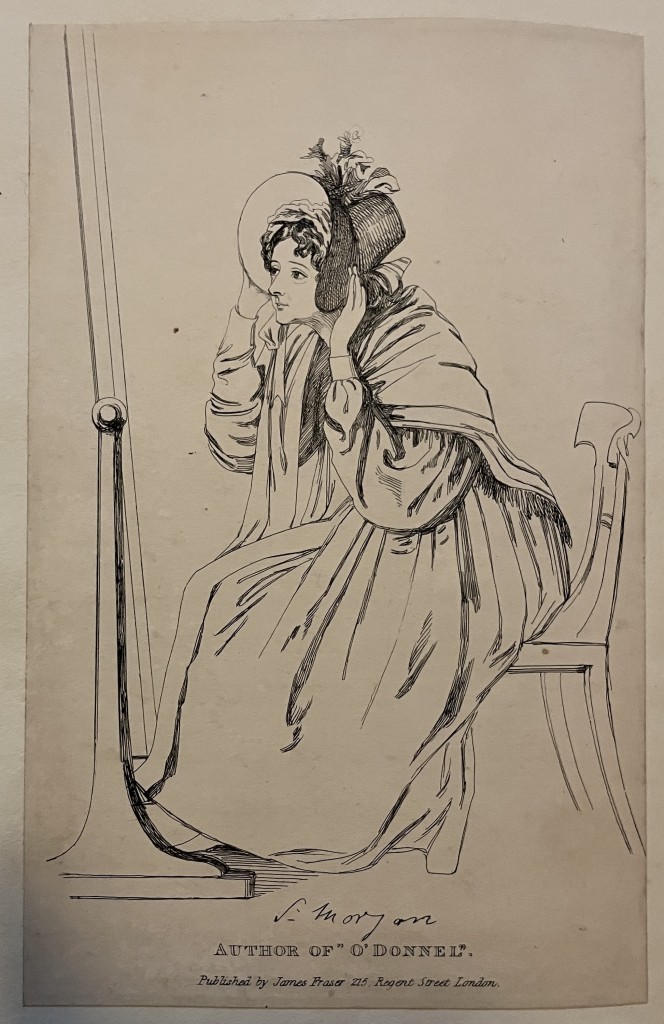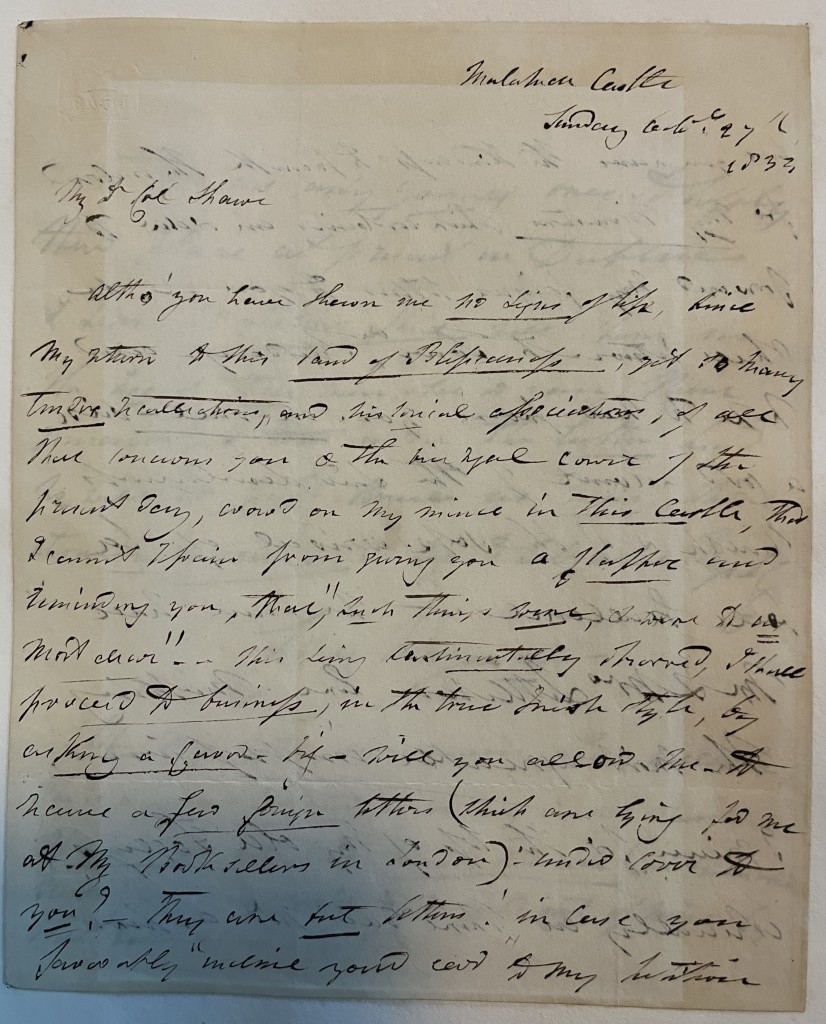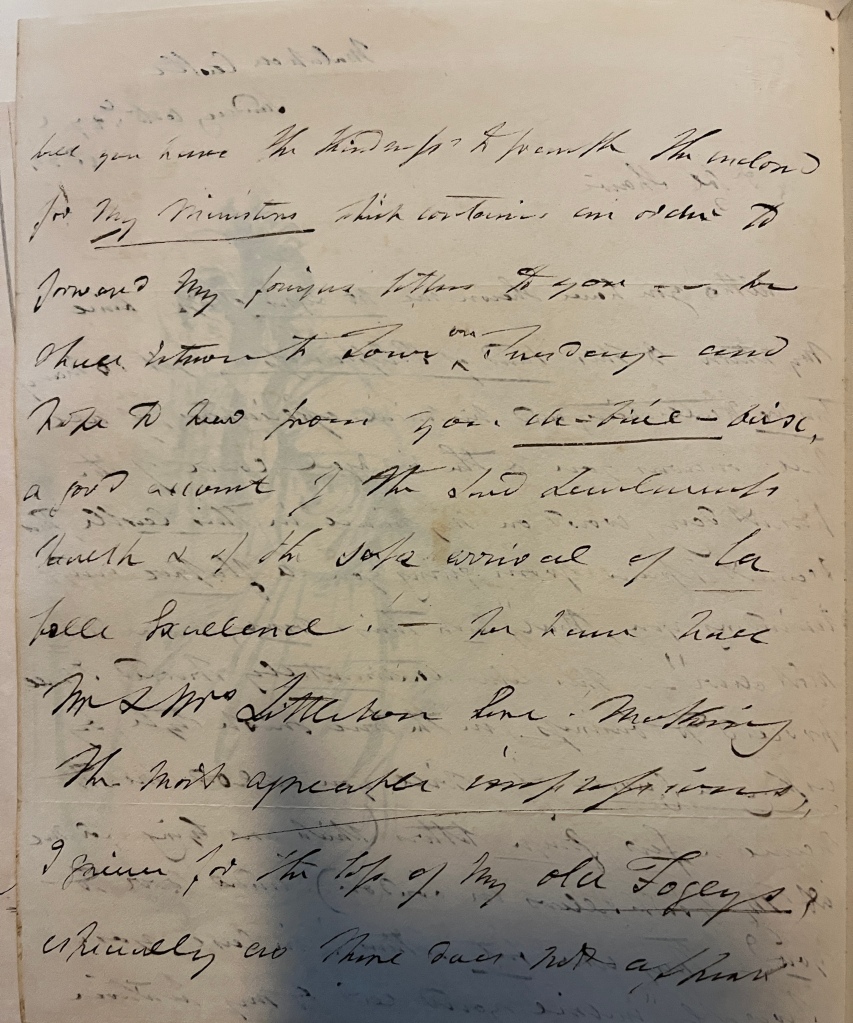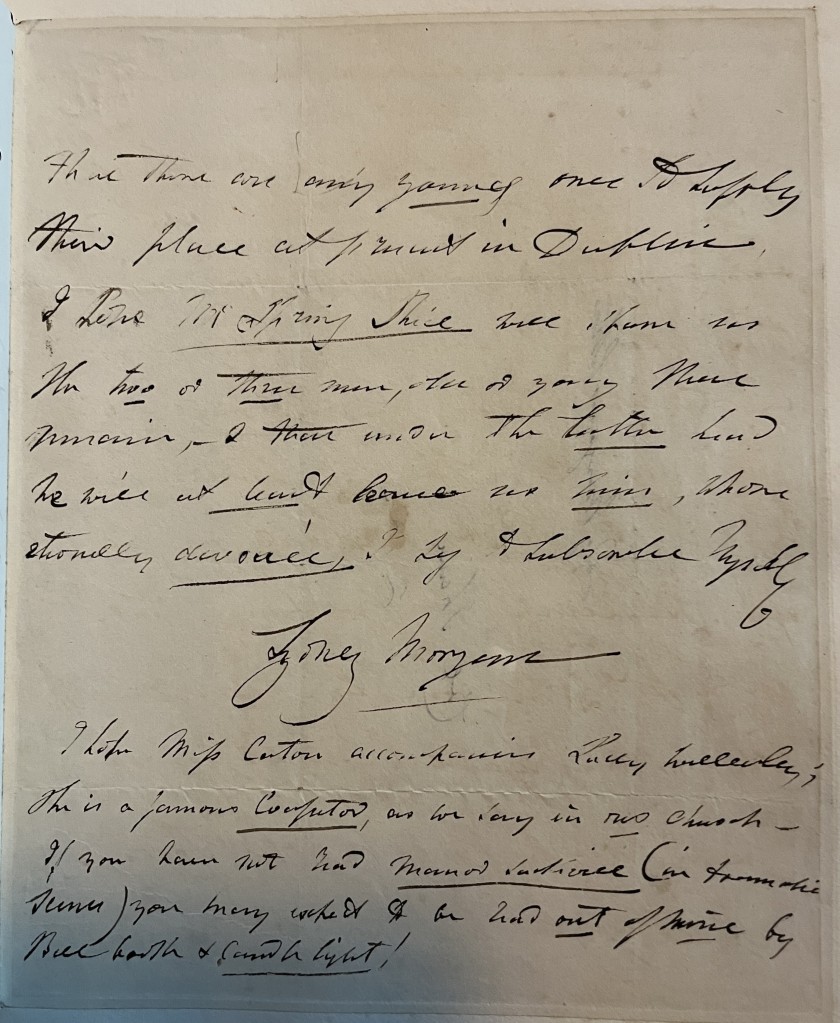For International Women’s Day 2024, the Magdalene libraries’ blog is showcasing a letter written by the Irish novelist Lady Sydney Morgan, née Owenson (bap. 1783, d. 1859). In the College’s Old Library, a letter by Sydney Morgan can be found in a collection of autographs and engraved portraits compiled by Jean-Sylvain Van de Weyer (1802-1874), a Belgian diplomat in the court of Queen Victoria. The Van de Weyer collection was donated to Magdalene College in the 1970s.
Sydney Morgan was the daughter of Robert Owenson, an Irish actor and theatre manager, and Jane Hill, of a merchant family. A prolific author, Morgan completed nine novels, of which the most famous is ‘The Wild Irish Girl’ published in 1806. She also published poetry, drama, essays and travelogues. Morgan was widely discussed in contemporary literary circles, often due to her combative writing style, and could count amongst her readers Lord Byron, Mary Russell Mitford, Percy Bysshe Shelley, Sir Walter Scott and Maria Edgeworth.[i] Professor Claire Connolly summarises Sydney Morgan and her sister Olivia’s circumstances as having ‘made their way from backstage life and rented lodgings to dining rooms and salons. Their talents, work and connections helped to shape Irish romantic culture’[ii].
A full transcription of the letter is as follows:
Malahide Castle
Sunday Octr. 27th
1833
My Dr Col Shawe
Altho’ you have shewn me no signs of life, since
my return to this land of Blessedness, yet so many
tender recollections, and historical associations, of all
that concerns you & the vice regal court of the
present day, crowd on my mind in this Castle, that
I cannot refrain from giving you a flapper and
reminding you, that, “such things were, & were to us
most dear”.—This being sentimentally observed, I shall
proceed to business, in the true Irish style, by
asking a favor—viz—will you allow me—to
name a few foreign letters (which are lying for me
at my Booksellers in London),—under cover to
you? —They are but letters! in case you
favorably “incline your ear” to my petition
will you have the kindness to frank the inclosed
for my Ministers which contains an order to
forward my foreigns letters to you.—We
shall return to Town ^\on/ Tuesday—and
hope to hear from you, de-bisée-birse,
a good account of the Lord Lieutenants
health & of the safe arrival of la
belle Excellence.—We have had
Mr & Mrs Littleton here, making
the most agreable impressions,
I grieve for the loss of my old Fogeys,
especially as there does not appear
that there are any younger ones to supply
their place at present in Dublin,
I hope Mr Spring Rice will spare us
the two or three men, old or young that
remain,—& that under the latter head
he will at least leave us him, whose
eternally devouée, I beg to subscribe myself
Sydney Morgan
I hope Miss Caton accompanies Lady Wellesley;
She is a famous Coajutor, as we say in our church—
If you have not read Manor Sackvill (in dramatic
scenes) you may expect to be read out of mine by
Bell book & Candle light![iii]
It is unclear how the Old Library’s letter by Sydney Morgan came to be acquired by Jean-Sylvain Van de Weyer. The letter’s recipient is Colonel Merrick Shawe, secretary to the Lord Lieutenant of Ireland Marquess Wellesley, who is also mentioned in the letter. However, it is evident that Van de Weyer sought to acquire extra portrait prints and correspondence of people he was acquainted with. From Lady Morgan’s memoirs, we know that she met Van de Weyer in the May of 1835, at a party hosted by Charles Babbage. Morgan describes Van de Weyer as ‘charming, spirituel and observing. He inspires one with views and opinions similar to his own, and we agree upon most things.’[iv]No doubt the pair had plenty to talk about: Morgan had visited Belgium in the preceding month, where she had visited the Belgian Archives[v], and had made mutual acquaintances.

Like Jane Porter’s letter covered previously in our blog for International Women’s Day, Morgan’s has administrative elements: she asks Colonel Shawe to frank her letters. However, she also hints at her lively social life, as told in her published journals and memoirs, and reported on by contemporary newspapers.
We see that Morgan peppers her letters with French phrases – ‘la belle excellence’ when referring to Marchioness Wellesley, for example. Lady Morgan was in fact famous for this, as shown from a short article in the newspaper ‘The Freeman’s Journal’ published three days before this letter was written. The anonymous author of the newspaper article writes: ‘We have recently seen some sheets of a very interesting work printing at Paris, in which the author interlards his French correspondence with scraps of English, in the way Lady Morgan mosaics her writings with bad French and Italian.’[vi]
Also mentioned in the letter is Manor Sackville, the first of a group of Dramatic Scenes and Sketches written by Morgan and published in the July of 1833. Geraldine Jewsbury, a friend who assisted with the publication of Morgan’s autobiography and selected correspondence, describes Manor Sackville as giving ‘a lively picture of Irish country life, an old Irish mansion unexpectedly visited by its proprietor, an enlightened and benevolent man, accompanied by his wife, an amiable, fine lady, and a party of fashionable friends from London’[vii]. However, the local newspapers did not treat Morgan so kindly. In ‘The Freeman’s Journal’, an anonymous author writes that the Dramatic Scenes ‘would subject the writer, in other and severer days, to the tumbril or the cucking-stool, as a communis rixatrix in politics. However, Lady Morgan seems determined to be the executioner of her own literary reputation.’[viii]
Lady Morgan states that she grieves for the loss of her ‘Old Fogeys’. It is most likely that Morgan is using this expression with its original meaning: a nick name for an invalid or garrison soldier[ix]. Morgan was a supporter of health care in Ireland: she was a patroness of the Maison de Sante[x], a hospital in Dublin for those unable to afford medical care at home.
The wealth of correspondence from several eminent 19th century figures in the Van de Weyer albums, including Sydney Morgan and Jane Porter, is now coming to light due to an ongoing cataloguing project of these albums. Later this year, this project will enable researchers and the wider public to search the contents of these albums online.
By Catherine Sutherland
Special Collections Librarian
All images used in this blog are the copyright of the Master and Fellows of Magdalene College Cambridge. To reproduce these images in any format, including online, permission from the College must be sought. For further information please see the College website.
[i] Dean, D.R. “Morgan [née Owenson], Sydney, Lady Morgan (bap. 1783, d. 1859), novelist and socialite.” Oxford Dictionary of National Biography. 23 Sep. 2004, Accessed 29 Jan. 2024.
[ii] Connolly, C. “‘More than Kin and More than Kind’: The Owenson Sisters, Lady Sydney Morgan and Lady Olivia Clarke.” In Sisters: Nine Families of Sisters Who Made Their Mark on Irish Life, edited by Siobhán Fitzpatrick and Mary O’Dowd, 83–106. Dublin: Royal Irish Academy, 2022.
[iii] With thanks to Grace Collingwood, Prof Claire Connolly, Adam Green and Isobel Renn in a group effort to decipher Lady Morgan’s handwriting.
[iv] Morgan, D. and Dixon, W.H. Lady Morgan’s Memoirs : Autobiography, Diaries and Correspondence, vol.2 p.399. London: W. H. Allen, 1863.
[v] “The Morning Chronicle”. Morning Chronicle [1801], 16 Sept. 1833. British Library Newspapers, Accessed 26 Jan. 2024.
[vi] “French-English.” Freeman’s Journal, 24 Oct. 1833. British Library Newspapers, Accessed 22 Jan. 2024.
[vii] Morgan, D. and Dixon, W.H. Lady Morgan’s Memoirs : Autobiography, Diaries and Correspondence, vol.2 p.354. London: W. H. Allen, 1863.
[viii] “Literature.” Freeman’s Journal, 3 Sept. 1833. British Library Newspapers, Accessed 22 Jan. 2024.
[ix] Oxford English Dictionary, s.v. “old fogey (n.), sense 1,” July 2023, Accessed 22 Jan. 2024.
[x] “Advertisements & Notices.” Freeman’s Journal, 8 Apr. 1833. British Library Newspapers, Accessed 26 Jan. 2024.


